Kelaniya - most important temple in the area of Colombo
all 20 slide show images by courtesy of Mr. Günter Schönlein from Germany
|
The temple of Kelaniya is the most important Buddhist sanctuary near Colomvo far and wide. The adjacent Vibhishana shrine is a Ramayana site and is thereby sacred to Hindus, too. The Buddhist temple is famous for its murals, which are partly in the Kandyan style, partly painted by Sri Lanka’s artist Solias Mendis.
|
Hindu legends surrounding Kelaniya
There is an abundance of old legends associated with Kelaniya. It‘s probable that it had been a sanctuary already in the pre-Buddhist period, namely a place of Vibhishana worship. A temple for this deity is still included in the monastic compound.
Vibhishana is sometimes considered to be the specific guardian deity of the west of the island. Though a member of the pantheon of the highest four gods of the island in the Gampola period, deities often associated with the four quarters, Vibhishana was not one of the main deities of the Sinhalese in earlier periods, when Kataragama, Natha, Upulvan and Saman were venerated as the highest fods. Rather, Vibhishana is a deity held in higher esteem among Hindus. He is also worshiped in India and Southeast Asia as one of the main characters of the Indian national epic Ramayana. Vibhishana is the brother of Ravana, the ruler of Lanka. He disapproves of Ravana‘s kidnapping of Rama's wife Sita and is therefore repudiated by his brother Ravana. Vibhishana then joins Rama and provides invaluable services for his campaign to free Sita due to his profound local knowledge on the island of Lanka.
|
Vibhishana - a memorable characterVibhishana is an interesting and remarkable character of the Ramayana, insofar he does not fit well into this epic‘s common pattern of being either a good or bad person. His criticism of the abduction of another man’s wife and his friendship with the divine hero Rama, of course, make him a positive figure. Despite of this, the taint of disloyalty to his family sticks to him. Vibhishana is considered a kind of traitor, who delivers his home to invaders. His treason has not prevented him from receiving divine honours among the Sinhalese population, though he is a demonic kind of deity, not payed homage to out of love for him but to reassure him, loyality being helpful to avoid his anger. Vibhishana worship is not known across the entire island. It’s a regional cult in the Kelaniya area. According to local legends, Vibhishana moved the capital of the island from the mythical Alakamanda in the highlands to Kelaniya. However, the Ramayana epic of Valmiki, though telling the story of Rama coronatiing Vibhishana as the island’s new king after the demise of Ravana, does not make any mention of these names as Lanka’s capitals. |
 Buddha giving his sermon to the demons in Mahiyangana, painted by Solias Mendis
Buddha giving his sermon to the demons in Mahiyangana, painted by Solias Mendis
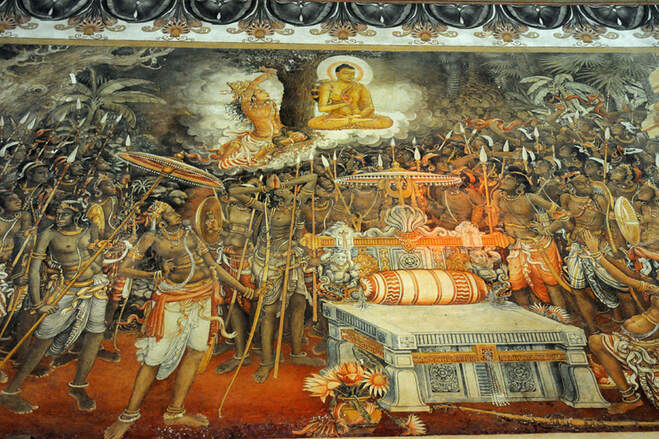 Sri Lanka's gem throne for the Buddha, painted by Solias Mendis
Sri Lanka's gem throne for the Buddha, painted by Solias Mendis
|
There is another famous legend surrounding Kelaniya, which is told in the Mahavamsa in connection with the birth of the chronicle’s main protagonist, namely the national hero Dutthagamani. His mother, Vihara Mahadevi, is a princess from Kelaniya. Her father was King was Kelani Tissa. In the course of a love affair between his wife and his brother, the king cruelly executed the abbot of the temple, who was innocently suspected of having conspired with the couple. This brutal injustice incensed the gods so much that they churned the sea causing a flood wave against Kelaniya. In order to avert the flooding of the kingdom, King Kelani Tissa was forced to sacrifice his beloved daughter. He released Vihara Mahadevi on a boat and left her to the floods, a scene depicted in another of Mendis‘ paintings. However, the princess survived, her boat was washed ashore in the very south of the island. Local legend has it that this occured at Kirinda Beach. Vihara Mahadevi then was married to Kakavanna Tissa, the king of the southern kingdom of Rohana, who named her Vihara Mahadevi, which literally means "Monastery Grand Goddess", because she stranded at a monastery. She gave birth to his son Duthagamani, who later on became the conquerer of Anuradhapura.
|
It is said today that Kelaniya has only been so close to the sea since that enormous flood. The story of the courtly affair and a devastating flood, after 2004, has been interpreted by many as a tsunami more than two thousand years ago.
The story of Vihara Mahadevi is told in Chapter 22 of the Mahavansa (Mahawamsa):
"Now in Kalyani the ruler was the king named Tissa. His younger brother named Ayya-Uttika, who had roused the wrath (of Tissa) in that he was the guilty lover of the queen, fled thence from fear and took up his abode elsewhere. The district was named after him. He sent a man wearing the disguise of a bhikkhu, with a secret letter to the queen. This man went thither, took his stand at the king's door and entered the king's house with an arahant who always used to take his meal at the palace, unnoticed by that thera. When he had eaten in company with the thera, as the king was going forth, he let the letter fall to the ground when the queen was looking. The king turned at the (rustling) sound, and when he looked down and discovered the written message he raged, unthinking, against the thera, and in his fury he caused the thera and the man to be slain and thrown into the sea Wroth at this the sea-gods made the sea overflow the land; but the king with all speed caused his pious and beautiful daughter named Devi to be placed in a golden vessel, whereon was written 'a king's daughter', and to be launched upon that same sea. When she had landed near to (the) Lanka (vihara) the king Kakavanna consecrated her as queen. Therefore she received the epithet Vihara." cited from: https://www.budsas.org/ebud/mahavamsa/chap022.html |
|
The significance ot the Kelaniya Buddhism for the Theravada school in the 15th century can be seen from the following event: In 1424 and in 1476, monk delegations from Cambodia and Thailand and from Burma came to Kelaniya to study Theravada Buddhism more thoroughly or to renew their higher ordination to introduce new lineages in their countries of origin. The event of utmost significance for Burmese Buddhism is not recorded in the chronicles and documents of Sri Lanka but in those of Burma (Myanmar). One of the most important historical sources for Burmese history are inscriptions named after their location, the Kalyanithein monastery in Pegu (Bago). The name of this monastery, "Kalyani", is one of the common spellings of the Sinhalese "Kelaniya" in Pali, the sacred language of Theravada Buddhism. The founder of the said monastery in Pegu was an important Burmese king known as Dhammacheti. This king, descended from the Mon people, had been a monk who helped Queen Shin Sawbu to escape from the then Burmese capital, Ava. In Pegu, she ascended the throne in 1453. However, she decided to retire to monastic life at the Schwedagon Pagoda in Rangoon (Yangon) and transferred power to her closest advisor, the monk Dhammacheti. He left the order - which does not result in a loss of prestige in Burma - and as king he considered a comprehensive reform of the Buddhist order to be his major task and achievement. In the history of Buddhism, kings have repeatedly emerged as "cleaners" of the Sangha from grievances, they modeled themselves after the great Indian emperor, Ashoka. The reform of the Dhammacheti is one of the most famous examples of this tradition of „cleansing the order“. Many Burmese monasteries had become almost secular institions at that point in time and many monks were doing business and were engaged in astrology, which is violation of the canonical Vinaya rules of the Buddhist Order. The chain of succession is only considered valid if the monks who witnessed the ordination had led a regular religious life up to the time of the ordination ceremony of a new member of the order. This could raise doubts concerning the validity of higher ordinations, in case of rumours that one of the witnesses had previously violated monastic rules. Dhammacheti himself belonged to a smaller group of monks, a reformed order with stricter regulations, which was founded around 1200 in Pagan (Bagan) by the monk Chappata (Sapada, also known as Sagata), who had renewed his ordination in Sri Lanka. Accordingly, this Burmese order was named "Sinhala Order" after the country of origin of the line of ordination.
|
Kalyani tradition in Lower BurmaIn the early months of 1476, Dhammacheti sent 22 monks on two ships to Sri Lanka in order to reorganize the entire monastic tradition of the Mon-dominated southern Burma. The destination of the ships was the port of Kelaniya. In July of the same year a large ceremony was held in Kelaniya and the guests from Lower Burma received a new ordination. For this purpose, a floating pavilion had been built in the Kelani River to define the Sima (borders) of the place of the ceremony unambiguously. After the monks reordained in the Sinhalese lienade had returned to Pegu, the new monastic rule set up by them was named after the place of origin, "Kalyani". The report, composed in both the local Mon and the sacred Pali laguarge, was laid down on ten stone tablets languages in the said monastery Kalyanithein (also known as Kalyanisima in Pali). All Burmese monks were invited to be re-ordained here in Pegu. Although the Kingdom of Pegu, dominated by the Mon, was conquered and devastated by the Burmese in 1539 and 1551, Dhammacheti's religious reform prevailed throughout Burma. Today, all Burmese monks attribute their ordination to the Sinhalese line of succession established in Kelaniya in 1476. |
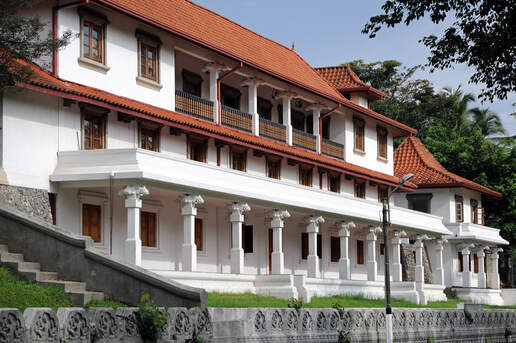
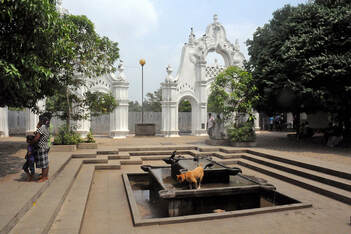
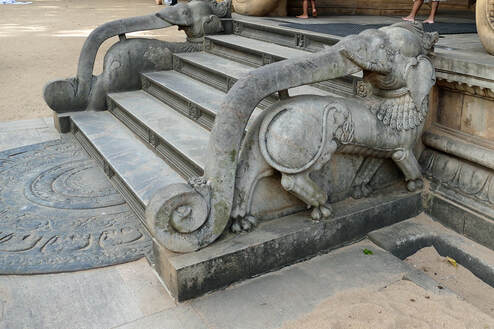 photo courtesy of Günter Schönlein
photo courtesy of Günter Schönlein
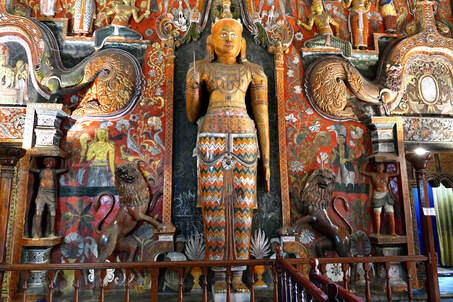 photo courtesy of Günter Schönlein
photo courtesy of Günter Schönlein
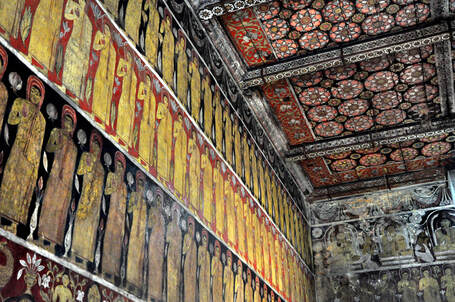
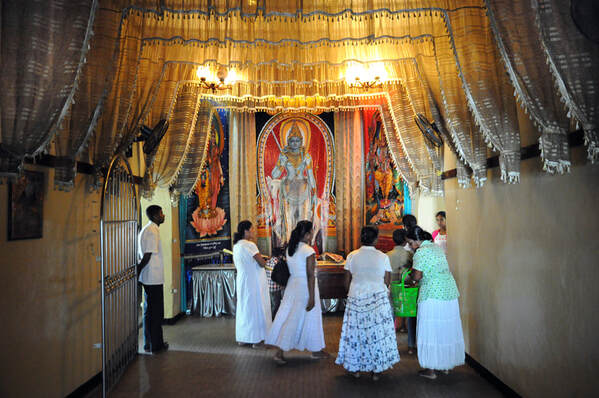
|
Find a list of 270 Sri Lanka travel destinations & attractions: CLICK HERE Our illustrated list of places of interest is sorted by travel regions, more precisely: by 22 most recommendable places for overnight stays. All 270 sights are within day-trip distance from one of those 22 major locations. (Please understand: Loading 270 images requires more seconds than usual.) |
|
Lanka Excursions Holidays
Registration Number SLTDA/SQA/TA/02179
255/24, "Green Park" Dawatagahawatta, Thimbirigaskatuwa, Mahahunupitiya East, Negombo, Sri Lanka
Office: +94 31 223 991 Hotline: +94 71 6097795 [email protected] Lanka Excursions Holidays office hours 8.00 to 6.00 p.m. daily (except from June Fullmoon Day)
|